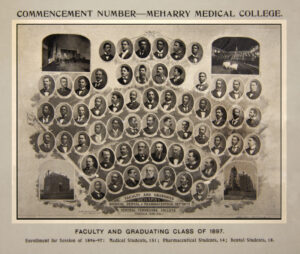Our History
In the 1820s, a young Ohioan by the name of Samuel Meharry was struggling to pull his fallen wagon from a ditch when a recently freed couple came to his aid.
Inspired by their compassion and courage, Meharry went on to return their random act of kindness by pledging the cash and property necessary to found Meharry Medical College.
Today, Meharry Medical College students serve as the living legacy of this freed couple’s courage and kindness.
Founded in 1876 as the Medical Department of Central Tennessee College, Meharry was the first medical school in the South for African Americans. It was chartered separately in 1915.
Today, Meharry includes a medical and dental school founded in 1886, a graduate school founded in 1938, a school of applied computational sciences founded in 2021, and most recently, a school of global health founded in 2023.
This is what Meharry is made of.
 Meharry Medical College was the first medical school in the South – historically black or otherwise – to offer four-year training.
Meharry Medical College was the first medical school in the South – historically black or otherwise – to offer four-year training.
In 1876, the Meharry Medical Department of Central Tennessee College admitted its first 11 students. At this time, the only two faculty members were Meharry co-founders Dr. William J. Snead and Dr. George W. Hubbard, who also served as Meharry’s first president and dean. Together, Snead and Hubbard gathered their small cohort in the basement of Clark Memorial United Methodist Church, where classes were then taught. But within ten years, Meharry quickly outgrew its humble beginnings. The College added a program for nurses and a program for dentists, effectively distinguishing itself as the emerging medical institution for African-Americans who want to make a difference in healthcare.
Meharry faculty make change.
Hulda Margaret Lyttle ’12
Hulda Margaret Lyttle served as Meharry’s director of nurses’ training and superintendent of Hubbard Hospital. Under her leadership, the school of nursing gained national accreditation.
Dr. Matthew Walker
Dr. Walker was Meharry’s surgery department chair. He established Meharry’s first surgical residency and played a pivotal role in enlisting community support for what would become the Matthew Walker Comprehensive Health Center in 1968.
Dr. E. Perry Crump ’41
Dr. Crump was a prominent physician, educator and the pediatrics department chair. During the Jim Crow era, Dr. Crump worked to improve healthcare access for African-Americans when medical services for Black communities were often neglected or substandard. He also studied the relationship between socio-economic factors and infant mortality.
Meharry leadership makes a better future.
Dr. Harold D. West, 5th President
In 1952, Dr. West became Meharry’s first African-American president. In 1957, he integrated what was once a segregated student body at Meharry. He also established Meharry’s department of psychiatry and social work and was the first to synthesize a new isomer of threonine.
Dr. Lloyd C. Elam, 6th President
Dr. Elam was an industrious and accomplished Meharrian. During his administration, 14 new facilities were built and Meharry became the first medical center in the nation to offer a comprehensive healthcare delivery system with teams headed by physicians and dentists. Under his leadership, Ph.D. courses in pharmacology, biochemistry, and microbiology were also established.
Dr. David Satcher, 8th President
Dr. Satcher was the U.S. Surgeon-General under Presidents Clinton and Bush. As president of Meharry, he coordinated a merger between Hubbard Hospital and Metro General that became the nation’s first Institute on Health Care for the Poor and Undeserved.
Dr. John E. Maupin, 9th President
Dr. Maupin was a staunch advocate of healthcare equity and accomplished administrator, educator and physician. During his administration, Meharry’s Centers for Women’s Health and AIDS Research were established.
